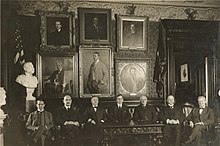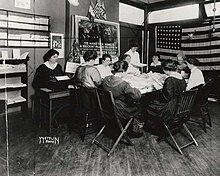Council of National Defense
 | |
| Agency overview | |
|---|---|
| Formed | August 24, 1916 |
| Preceding agencies |
|
| Dissolved | 1921 (suspended) Briefly revived for WWII to hold agencies such asNational Defense Research Committee (WWII) |
| Superseding agencies | |
| Jurisdiction | United States Government |
| Headquarters | Washington, D.C. |
| Agency executives |
|
| Parent agency | Executive Office of the President |
| Child agencies |
|
TheCouncil of National Defensewas aUnited Statesorganization formed duringWorld War Ito coordinate resources and industry in support of the war effort, including the coordination of transportation, industrial and farm production, financial support for the war, and public morale.

It was briefly revived forWorld War II[2]to hold agencies such asNational Defense Research Committee.
Organizational history[edit]
Establishment[edit]
The Army appropriation for 1916 provided for the creation and funding of the Council of National Defense.[3]The appropriation was $200,000.[4]PresidentWoodrow Wilsonestablished it on August 24, 1916,[5]because "The Country is best prepared for war when thoroughly prepared for peace."[4]
Members of some portions, such as the Medical Officers' Reserve Corps, which had existed previously as the Medical Reserve Corps, reverted to their former roles preparing for emergencies.[6]
Structure[edit]
The council consisted of theSecretary of War,theSecretary of the Navy,theSecretary of the Interior,theSecretary of Agriculture,theSecretary of Commerce,and theSecretary of Labor.[7]The council was to investigate and advise the president and heads of executive departments, on the strategic placement of industrial goods and services for the potential and future use in times of war.[5]
The President appointed a nonpartisan advisory commission associated with the council in October 1916.[4]The commission comprised seven men with specialized knowledge in a profession or field of industry.[7]Its first members wereDaniel Willard(Baltimore, Maryland), president of theBaltimore and Ohio Railroad;Samuel Gompers(Washington, D.C.), president of theAmerican Federation of Labor;Dr.Franklin H. Martin(Chicago, Illinois), a distinguishedsurgeonwho founded theAmerican College of Surgeons;Howard E. Coffin(Detroit, Michigan), head of theCommittee on Industrial Preparedness,who had experience coordinating the auto industry in emergencies;Bernard Baruch(New York, New York), a prominent banker; Dr.Hollis Godfrey,civil engineer[8](Philadelphia, Pennsylvania), president of theDrexel Institute;andJulius Rosenwald(Chicago, Illinois), president ofSears, Roebuck & Co.[4]Walter S. Gifford,of the American Telegraph and Telephone Company, also an engineer, served as the first Director of the Council,[9]but was succeeded byGrosvenor Clarkson.[10]
Women and African Americans[edit]

In April 1917,suffragist,Anna Howard Shaw,founded the Women's Committee of the Council of National Defense.[11]The committee was initially made up of Shaw,Carrie Chapman Catt,Maude A. K. Wetmore,Ida Tarbell,Mrs. Joseph E. Cowles,Antoinette Funk,Mrs. Phillip N. Moore, and Mrs. Joseph R. Lamar.[12]The Women's Committee helped match women with groups that had need for volunteers and also advised the defense council of how women could aid the war effort.[11][12]
Beginning in May 1917, the Council asked individual states to create their own Councils of Defense to assist the federal Council in carrying out its work.[3]There were 48 state Women's Committees formed.[13]Shaw appointed temporary chairs for each state committee in order to coordinate the upcoming war work.[14]
Some groups formed separate Women's Committees of National Defense and Southern states, at the urging of the National Council, formed organizations forAfrican Americans.[3]Alice Dunbar Nelsonworked as a field representative for the Women's Council.[15]
In January 1920, the Council recommended the creation of an Expert Survey Board to conduct research studies over the next six months to enable speedy mobilization in the event of another war.[16]
Disestablishment[edit]
The activities of the Council of National Defense were suspended in 1921.[3]
See also[edit]
- Committee on Public Information—Disbanded 1919 and records transferred to CND.
- National Defense Research Committee
- Railroads' War Board
- United States Housing Corporation
Footnotes[edit]
- ^Herman, Arthur.Freedom's Forge: How American Business Produced Victory in World War II,pp. 127, 137-9, Random House, New York, NY, 2012.ISBN978-1-4000-6964-4.
- ^"Records of the Council of National Defense".National Archives.August 15, 2016.RetrievedDecember 10,2016.
- ^abcdGreen, Walter G., ed.,Electronic Encyclopaedia of Civil Defense and Emergency Management,"Council of National Defense and State Defense Councils," August 17, 2003ArchivedJuly 22, 2011, at theWayback Machine,accessed May 9, 2011
- ^abcd"President Names Defense Advisors".The New York Times.1916-10-12.
- ^ab"Title 50: Chapter 1: Council of National Defense".U.S. House of Representatives Downloadable U.S. Code. January 2, 2006. Archived fromthe originalon February 28, 2008.Retrieved2008-02-24.
- ^Emerson, William K.,Encyclopedia of United States Army insignia and uniforms,183,available online
- ^ab"Laws: Cases and Codes: U.S. Code: Title 50. War And National Defense".FindLaw.Retrieved2008-02-24.
- ^Nunn, Jack H. (October 1979). "MIT: A University's Contributions to National Defense".Military Affairs.43(3). Society for Military History: 120–125.doi:10.2307/1986870.JSTOR1986870.
- ^Engineering news-record. v.78 1917., Cited in Pursell, Carroll. "Engineering Organization and the Scientist in World War I: The Search for National Service and Recognition." Prometheus 24.3 (2006): 257-268.
- ^"Heads Defense Council; Grosvenor B. Clarkson Succeeds W. S. Gifford as Director".The New York Times.1918-12-22.
- ^ab"Women in World War I".U.S. National Park Service.Archivedfrom the original on 2019-06-12.Retrieved2021-08-06.
- ^ab"Plan Co-Ordination for Work of Women".The Daily Missoulian.1917-05-06. p. 10.Retrieved2021-08-06– via Newspapers.
- ^"New York, May 9 -- Chairwomen".The Fresno Morning Republican.1917-05-10. p. 8.Retrieved2021-08-06– via Newspapers.
- ^"Economy the Crying Need".The Daily Appeal.1917-05-15. p. 2.Retrieved2021-08-06– via Newspapers.
- ^"African-American Participation During World War I".Division of Historical and Cultural Affairs - State of Delaware.Retrieved2021-08-06.
- ^"War Preparedness Methods Proposed".The New York Times.1920-01-26.Retrieved2011-05-09.
Further reading[edit]
- Records of the Council of National Defensedocuments the legion of subcommittees to the CND
Further reading[edit]
- William J. Breen,Uncle Sam at Home: Civilian Mobilization, Wartime Federalism, and the Council of National Defense, 1917-1919.Westport, CT: Greenwood Press, 1984.
External links[edit]
- Council of National Defense- text of legislation
- Council of National Defense
- Government agencies established in 1916
- Organizations disestablished in 1921
- United States home front during World War I
- Presidency of Woodrow Wilson
- Military history of the United States during World War I
- 1916 establishments in the United States
- 1921 disestablishments in the United States
